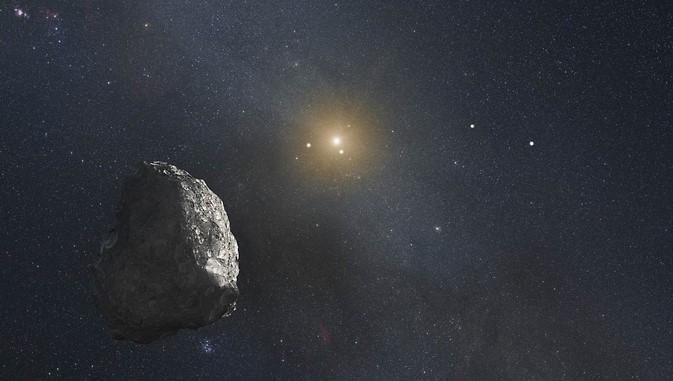This strangely orbiting space object could have ties to Planet Nine
An artist's rendering of an object located in the Kuiper Belt, where Niku was discovered. Image has been cropped.
Niku is the Chinese word for rebellious — and it’s the name scientists have given to a new space object that orbits wildly out of sync with the rest of our solar system. Located in the Kuiper Belt, beyond the orbit of Neptune, Niku is a piece of icy debris roughly 100 miles across. Recently, scientists discovered that Niku's orbital plane is tilted by 110 degrees to the sun. Not only that, but Niku also moves around the sun backward.
The astronomical community is taking note of the discovery because there’s just one other known object in our solar system with a similar orbit. Drac was discovered in 2008, also in the Kuiper Belt and travels backward at an inclination of about 100 degrees. Together, the odd orbits of Niku and Drac raise questions about what may have sent them spinning out of step millennia ago.
Konstantin Batygin, a professor of planetary science at the California Institute of Technology, says that except for its wild orbital path, nothing about Niku raises eyebrows in the neighborhood. The Kuiper Belt is a field of similarly icy debris objects, among them Pluto — which you'll remember was downgraded by astronomers from "planet" to "dwarf planet" about a decade ago.
“In fact, Pluto was the original Kuiper Belt object,” Batygin says. “And what led to its demotion was the discovery of the remainder of these other objects. So in any case, the Kuiper Belt typically has orbital periods in the order of hundreds of years — 200, 300 [years]. And Niku falls exactly in that regime. Its orbital period is almost 200 years.”
One theory about why Niku and Drac have such peculiar orbital paths involves Planet Nine, a distant, hypothetical ninth planet in our solar system. Batygin says that in their current positions, Niku and Drac are too close to Neptune for their orbits to be affected by Planet Nine’s gravitational influence. But what if Niku and Drac used to be closer to Planet Nine?
“The remarkable thing about Drac and Niku is that we really don't understand where they came from, Batygin says. “It's a totally open question.”
According to Batygin, the hypothesis that Planet Nine somehow sent Drac and Niku into their strange orbits is at least worth further investigation.
“We know that Planet Nine modifies the inclinations — the orbital planes — of objects that are further out, about maybe a factor of five or maybe seven further out than Niku and Drac,” Batygin says. “Could it be that the origin story for Niku and Drac is that they used to be further out, their plane got tilted and then by getting scattered by Neptune, [their orbits] sort of shrunk? Is that a reasonable story? I think it's a perfectly reasonable story to investigate.”
If one strangely orbiting space object is an anomaly, two strangely orbiting space objects are just the tip of the iceberg. Batygin and other scientists hope that the discovery of Niku will focus efforts on piecing together a new picture of the early solar system — perhaps one that sheds more light on Planet Nine.
“The fact that there are now two informs us of the fact that this is a real population, these are not two flukes that happen to have very similar orbital planes,” Batygin says. “This is a real population, and we need to figure out where it comes from.”
This article is based on an interview that aired on PRI's Science Friday.
